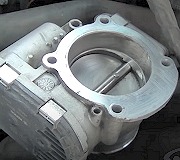Could be the PCM not targeting the idle speed
If a vehicle idles erratically and surges (idle speed is not steady and increases and decreases), the problem may be a buildup of carbon or fuel varnish deposits in the idle speed control valve (also called the idle air control valve or IAC valve). The cure for this condition is to clean the valve with some aerosol throttle cleaner or engine top cleaner.
Here's how to clean the IAC valve:
Disconnect the air intake ductwork from the throttle body.
Start the engine, then increase and hold the idle speed to 1,000 to 1,500 rpm.
Spray the throttle cleaner or engine cleaner into the throat of the throttle body, aiming for the idle air bypass port (usually located on the side or top of the throttle body opening). Give this area a good dose of cleaner (about 10 second's worth).
Turn the engine off to allow the cleaner to soak into the IAC passageway.
Wait about three minutes.
Restart the engine, rev and hold at 1,000 to 1,500 rpm, and repeat the cleaning process again.
Turn the engine off again, and reattach the air intake ductwork to the throttle body.
Start the engine and rev and hold to 1,500 to 2,000 rpm until no white smoke is coming out of the exhaust pipe.
If this fails to make any difference, you can remove the IAC valve from the throttle body and spray cleaner directly on the tip of the valve and/or into the ports in the throttle body. Let the cleaner soak awhile, repeat as needed, then reinstall the IAC valve, start the engine and run it at 1,500 to 2,000 rpm as before until no white smoke is seen in the exahust.
If the idle speed still surges after this, the IAC valve is defective and needs to be replaced.
Too fast an idle speed. If an engine without computerized idle speed control is idling too fast and refuses to come down to a normal idle speed despite your best efforts to back off the carburetor idle speed screw or air bypass adjustment screw (fuel injection), air is getting past the throttle somewhere. Common leak paths include the carburetor and throttle body gaskets, carburetor insulator spacers, intake manifold gaskets, and of course, any of the engine's vacuum fittings, hoses and accessories. It is even possible that leaky O-rings around the fuel injectors are allowing air to leak past the seals. Another overlooked item can be a worn throttle shaft and a defective idle speed speed control motor/valve stuck in the extended (high idle speed) position/throttle position sensor. Also the throttle plate could be binding in its bore and kinked accelerator cable, coolant temperature sensor might not be operating properly misleading the computer that the engine is still cold and computer throwing fuel at it raising the idle speed.
Thursday, November 13th, 2008 AT 5:29 AM



